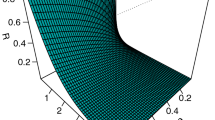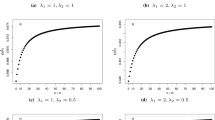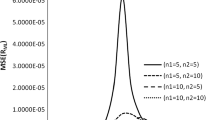Abstract
In this article, we develop Bayesian estimation procedure for estimating the stress strength reliability R = P [X > Y ] when X (strength) and Y (stress) are the inverse Chen random variables. First, we study some statistical properties of the inverse Chen distribution such as quantiles, mode, stochastic ordering, entropy measure, order statistics and stress strength reliability. Then, we estimate the stress strength parameters and R using maximum likelihood and Bayesian estimations. A symmetric (squared error loss) and an asymmetric (entropy loss) loss functions are considered for Bayesian estimation under the assumption of gamma prior. Since, joint posterior distribution of the model parameters and R involve multiple integrations and have complex form. So, we do not get analytical solution without using any numerical techniques. Therefore, we propose to use Lindley’s approximation and Markov chain Monte Carlo techniques for Bayesian computation. A simulation study is carried out for the proposed Bayes estimators of unknown parameters and compared with the maximum likelihood estimator on the basis of mean squared error. Finally, an empirical illustration based on failure time data is presented to demonstrate the applicability of inverse Chen stress strength model.





Similar content being viewed by others
Availability of data and material
Code availability
R-code is provided as per need for the reviewers.
References
Shi Y (2014) Big data: history, current status, and challenges going forward. Bridge 44(4):6–11
Olson DL, Shi Y (2007) Introduction to business data mining. McGraw-Hill/Irwin, New York
Shi Y, Tian YJ, Kou G, Peng Y, Li JP (2011) Optimization based data mining: theory and applications. Springer, Berlin
Tien JM (2017) Internet of things, real-time decision making, and artificial intelligence. Ann Data Sci 4(2):149–178
Chen Z (2000) A new two-parameter lifetime distribution with bathtub shape or increasing failure rate function. Stat Probab Lett 49(2):155–61
El-Gohary A, Alshamrani A, Al-Otaibi AN (2013) The generalized Gompertz distribution. Appl Math Model 37(1–2):13–24
Gupta RD, Kundu D (1999) Theory & methods: generalized exponential distributions. Aust New Zealand J Stat 41(2):173–88
Kundu D, Gupta RD (2006) Estimation of \(P[Y<X]\) for Weibull distributions. IEEE Trans Reliab 55(2):270–80
Sharma VK, Singh SK, Singh U (2014) A new upside-down bathtub shaped hazard rate model for survival data analysis. Appl Math Comput 239:242–53
Surles JG, Padgett WJ (2001) Inference for reliability and stress–strength for a scaled Burr type X distribution. Lifetime Data Anal 7(2):187–200
Srivastava PK, Srivastava RS (2014) Two parameter inverse Chen distribution as survival model. Int J Stat Math 11(1):12–16
Church JD, Harris B (1970) The estimation of reliability from stress–strength relationships. Technometrics 12(1):49–54
Birnbaum ZW (1956) On a use of the Mann–Whitney statistic. Proc Third Berkeley Symp Math Stat Probab 1:13–17
Birnbaum ZW, McCarty RC (1958) A distribution-free upper confidence bound for \(Pr\{Y<X\}\), based on independent samples of X and Y. Ann Math Stat 1:558–62
Al-Hussaini EK, Hussein M (2011) Estimation using censored data from exponentiated Burr type XII population. Am Open J Stat 1:33–45
Nasiri P (2011) Estimation of R=\(P(Y<X)\) for two-parameter exponential distribution. Aust J Basic Appl Sci 5:414–20
Wong A (2012) Interval estimation of \(P(Y<X)\) for generalized Pareto distribution. J Stat Plan Inference 142(2):601–7
Al-Mutairi DK, Ghitany ME, Kundu D (2013) Inferences on stress–strength reliability from Lindley distributions. Commun Stat Theory Methods 42(8):1443–63
Khamnei HJ (2013) Reliability for Lindley distribution with an outlier. Bull Math Sci Appl 2:23–8
Ali MM, Pal M, Woo J (2012) Estimation of \(p(y<x)\) in a four-parameter generalized Gamma distribution. Aus J Stat 41(3):197–210
Amiri N, Azimi R, Yaghmaei F, Babanezhad M (2013) Estimation of stress–strength parameter for two-parameter Weibull distribution. Int J Adv Stat Probab 1(1):4–8
Singh SK, Singh U, Sharma VK (2014) Estimation on system reliability in generalized Lindley stress–strength model. J Stat Appl Probab 3(1):61–75
Sharma VK, Singh SK, Singh U, Agiwal V (2015) The inverse Lindley distribution: a stress–strength reliability model with application to head and neck cancer data. J Ind Produ Eng 32(3):162–73
Sharma VK (2018) Bayesian analysis of head and neck cancer data using generalized inverse Lindley stressstrength reliability model. Commun Stat Theory Methods 47(5):1155–80
Kumar M, Pathak A, Soni S (2019) Bayesian inference for Rayleigh distribution under step-stress partially accelerated test with progressive type-II censoring with binomial removal. Ann Data Sci 6:117–152
Eliwa M, El-Morshedy M (2019) Bivariate Gumbel-G family of distributions: statistical properties, Bayesian and non-Bayesian estimation with pplication. Ann Data Sci 6(1):39–60
Goyal T, Rai PK, Maurya SK (2020) Bayesian estimation for GDUS exponential distribution under type-I progressive hybrid censoring. Ann Data Sci 7:307–345
Mahmoud MAW, Ghazal MGM, Radwan HMM (2020) Bayesian estimation and optimal censoring of inverted generalized linear exponential distribution using progressive first failure censoring. Ann Data Sci. https://doi.org/10.1007/s40745-020-00259-z
Yousaf F, Ali S, Shah I (2019) Statistical inference for the Chen distribution based on upper record values. Ann Data Sci 6:831–851
Bhatti FA, Hamedani GG, Najibi SM, Ahmad M (2019) On the extended Chen distribution: development, properties, characterizations and applications. Ann Data Sci. https://doi.org/10.1007/s40745-019-00202-x
Anzagra L, Sarpong S, Nasiru S (2020) Odd Chen-G family of distributions. Ann Data Sci. https://doi.org/10.1007/s40745-020-00248-2
Milgram MS (1985) The generalized integro-exponential function. Math Comput 44(170):443–58
Kenney JF, Keeping ES (1962) Skewness. 7.10 in mathematics of statistics, Pt. 1, 3rd edn. Van Nostrand, Princeton
Moors JJ (1988) A quantile alternative for kurtosis. J R Stat Soc Ser D (Stat) 37(1):25–32
Shaked M, Shanthikumar JG (2007) Stochastic orders. Springer, Berlin
Singh PK, Singh SK, Singh U (2008) Bayes estimator of inverse Gaussian parameters under general entropy loss function using Lindley’s approximation. Commun Stat Simul Comput 37(9):1750–62
Lindley DV (1980) Approximate Bayesian methods. Trabajos de estadstica y de investigacin operative 31(1):223–45
Robert CP, Casella G (2004) Monte Carlo statistical methods. Springer, New York
Geman S, Geman D (1984) Stochastic relaxation, Gibbs distributions, and the Bayesian restoration of images. IEEE Trans Pattern Anal Mach Intell 6:721–41
Casella G, George EI (1992) Explaining the Gibbs sampler. Am Stat 46(3):167–74
Metropolis N, Rosenbluth AW, Rosenbluth MN, Teller AH, Teller E (1953) Equation of state calculations by fast computing machines. J Chem Phys 21(6):1087–92
Hastings WK (1970) Monte Carlo sampling methods using Markov chains and their applications. Biometrika 57(1):97–109
Proschan F (1963) Theoretical explanation of observed decreasing failure rate. Technometrics 5(3):375–83
Acknowledgements
The author would like to thanks editor-in-chief and two anonymous referees whose suggestions led to substantial improvement on the manuscript. Author also grateful thanks to Dr Jitendra Kumar, Department of Statistics, Central University of Rajasthan, Ajmer and Dr Vikas Kumar Sharma, Department of Statistics, Banaras Hindu University, Varanasi, India for improving the initial draft of the manuscript.
Funding
Not applicable.
Author information
Authors and Affiliations
Corresponding author
Ethics declarations
Conflict of interest
The authors declare that they have no conflict of interest
Additional information
Publisher's Note
Springer Nature remains neutral with regard to jurisdictional claims in published maps and institutional affiliations.
Appendix
Appendix
Rights and permissions
About this article
Cite this article
Agiwal, V. Bayesian Estimation of Stress Strength Reliability from Inverse Chen Distribution with Application on Failure Time Data. Ann. Data. Sci. 10, 317–347 (2023). https://doi.org/10.1007/s40745-020-00313-w
Received:
Revised:
Accepted:
Published:
Issue Date:
DOI: https://doi.org/10.1007/s40745-020-00313-w




